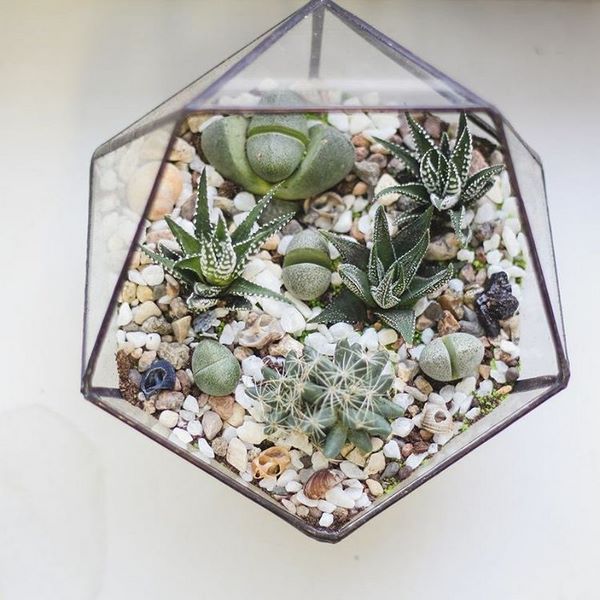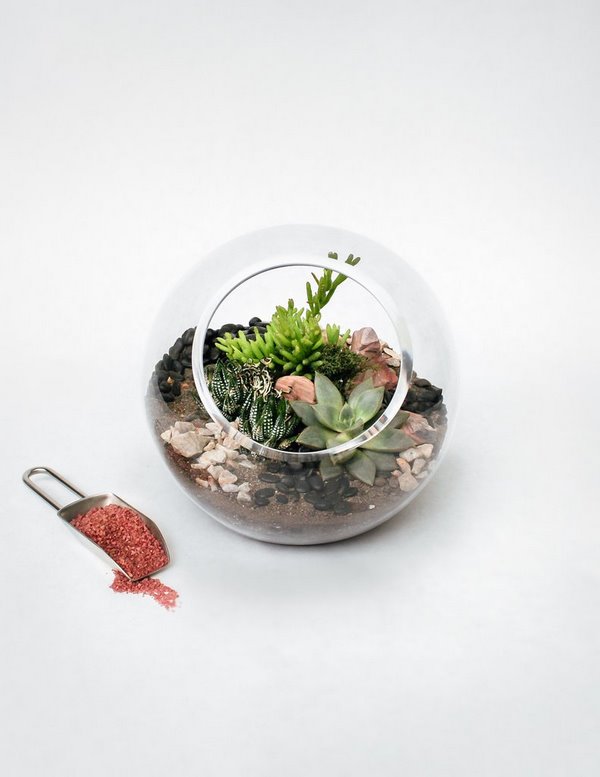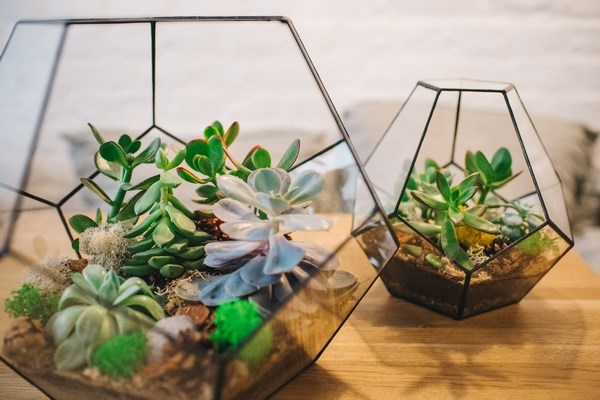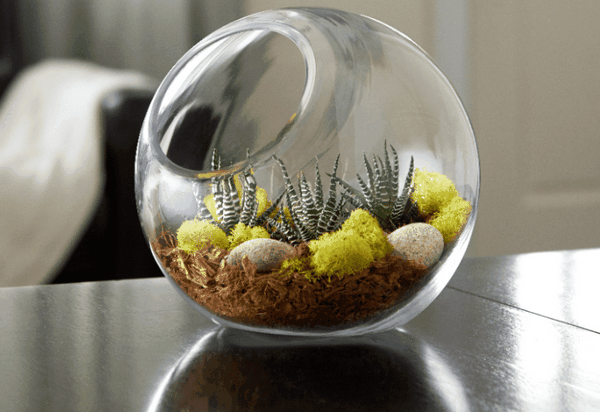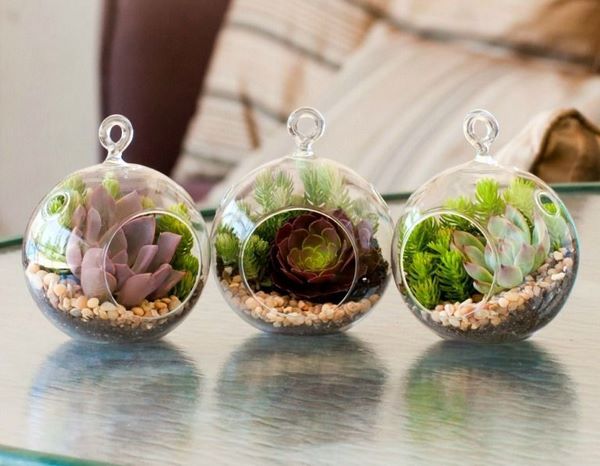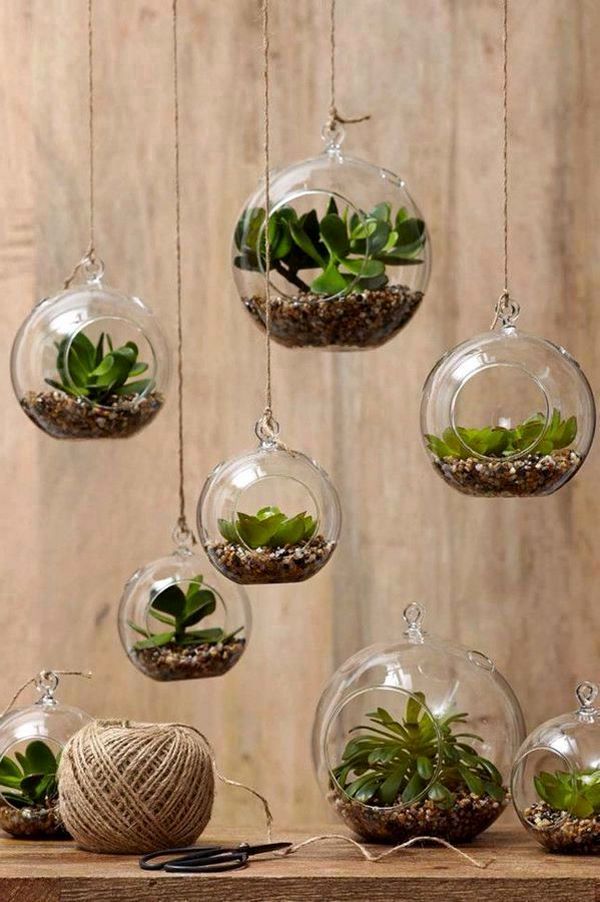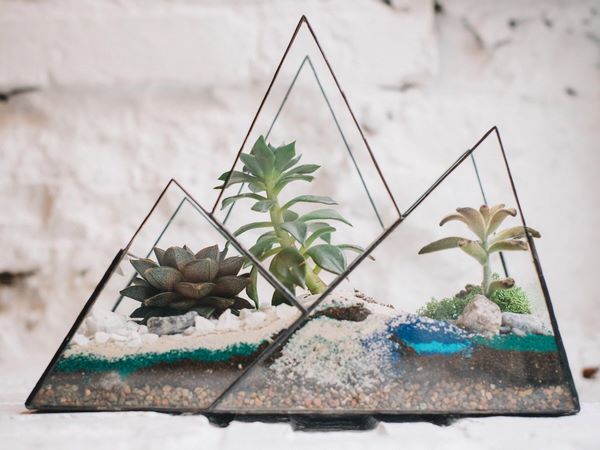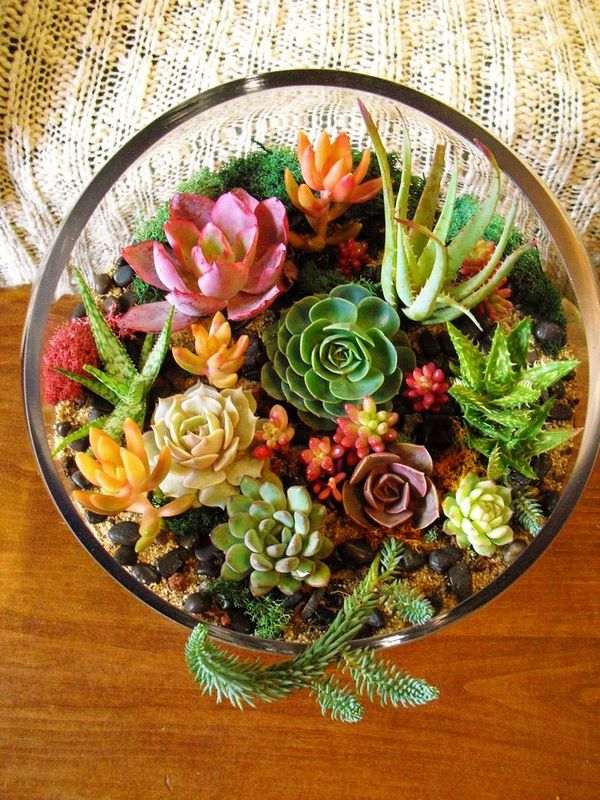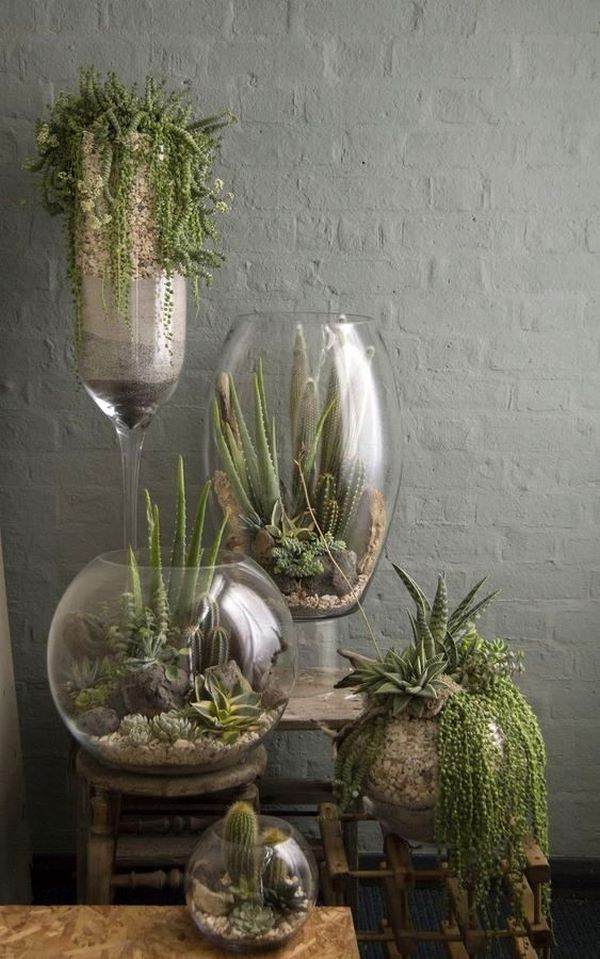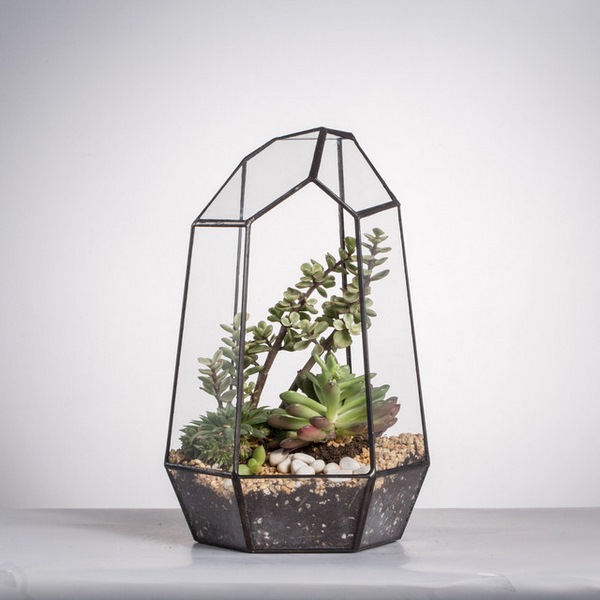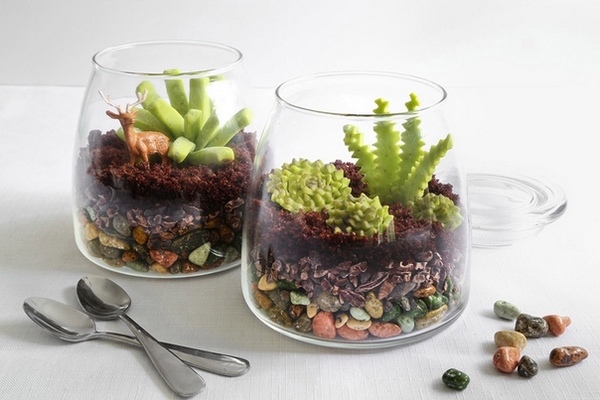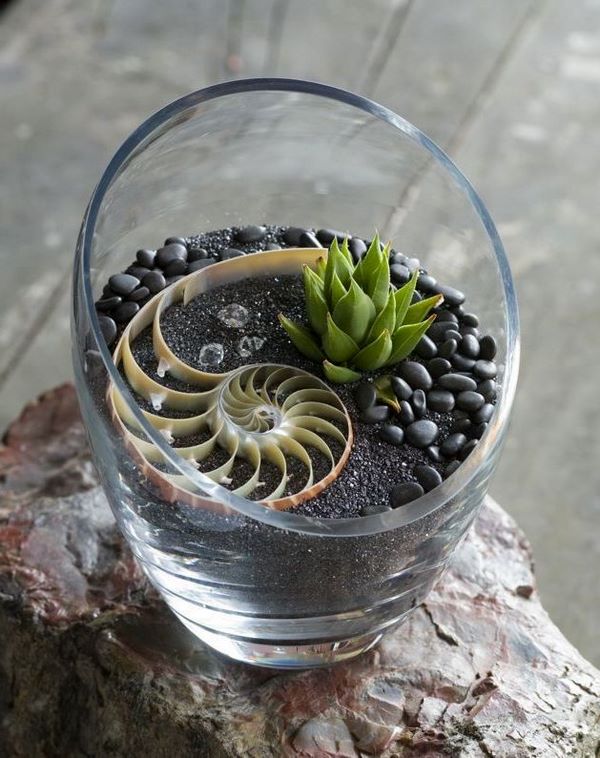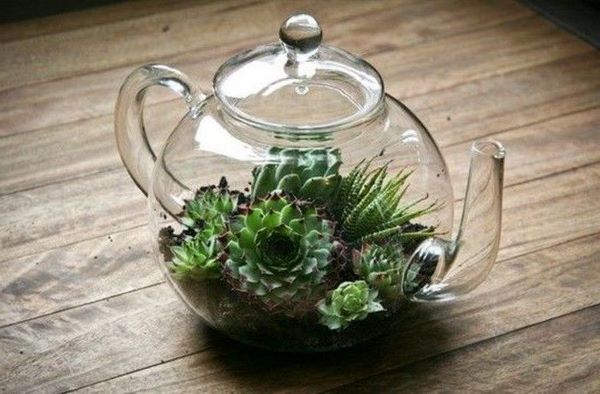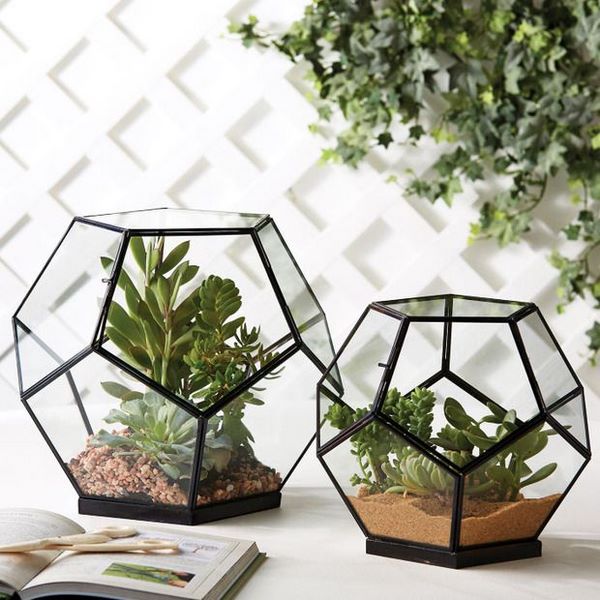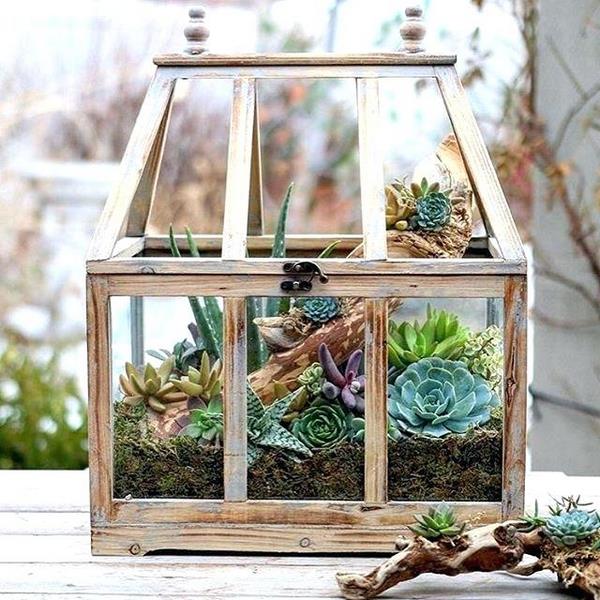We will show you some of the best DIY succulent terrarium design ideas which can inspire you create the most original home decoration and proudly display your composition. The times when the windowsill or the flower stands were the options to create floral compositions are long gone. When it comes to interior gardening and house plants, flower arranging techniques offer amazingly beautiful ideas for miniature indoor gardens which are a beautiful element in the interior. Terrariums are widely popular and fashionable as they offer a special way of using plants in creative and original ways.
What is a terrarium? Terrariums are compositions from plants which require with minimal resources and maintenance. You can describe it as a small indoor greenhouse, a transparent container made of glass or plastic with plants inside. Initially terrariums were used as a place where you can create a special micro-climate favorable for capricious and rare plants. The dry air in the winter season, the lack of natural light, the cold from the windowpane on the windowsill and the lack of time for regular care often put an end to the dream of having your own tropical garden. Today terrariums are used for single plants or compositions and their design can vary from minimalist to exceptional miniature landscapes and are the ideal solution for those who like exotic plants, but the climatic conditions of an urban apartment do not allow their breeding.
The revival of terrariums is due to the work of many interior designers. Along with the return of vintage interiors and the popularity of natural materials, decorators and designers took the Victorian compositions of succulents, which were used to decorate the dining table and began using them in living rooms, bedrooms, offices, etc. Generally, terrariums combine art and botany in a unique composition, which literally recreates a part of wildlife in your home. A home garden behind a glass, or a terrarium is unique in terms of coziness and energy, it draws attention and it can be a fantastic decorative accent and a luxurious accessory.
DIY succulent terrarium design ideas – basic rules and elements in a composition
The design of succulent terrariums is a matter of taste and aesthetic preferences. To decorate your house, you can buy one in the decor stores or make a mini garden by yourself. A DIY option is not only fascinating, but also opens up unique opportunities for creativity. You can either buy a ready-made set consisting of plants and all the necessary materials, or buy different components separately, creating your own unique terrarium.
The main purpose is to maintain a more or less stable level of humidity and temperature, as in a greenhouse. Special equipment for heating and lighting can make the terrarium independent from the source of natural light and heat which will allow you to grow the most capricious plants that require certain conditions and care. The good news is that succulents, in general, are low-maintenance plants and in addition, they are very durable. Of course, you need to remember that your succulents will grow slowly and sooner or later a small capacity container will be insufficient. In such cases succulents can be transplanted into pots and you can arrange a new composition in the glass container.
Before you buy or start a DIY succulent terrarium, you should know a few rules. The terrarium greatly limits the access of air to plants, and sometimes it can be completely blocked. As a result, the plants will never be exposed to draught. Also, the air inside is more humid than in the room, which creates the effect of a greenhouse. This feature allows you to grow fanciful plants, which grow poorly in ordinary room conditions. The choice of terrarium plants depends on the location of the light source. If the container is located far from the light source, ferns and cacti will grow well. If the terrarium is located in a bright place, then it is possible to plant plants that require hothouse conditions.
What are the main elements in a terrarium? When you start looking for DIY succulent terrarium design ideas, you will notice that most arrangements have some common components.
Glass container – As a rule, terrariums are made of glass or dense translucent plastic. You can also find wooden models or combined, with transparent inserts. The market offers a huge variety of options – from small orbs to unique polygonal containers, but you can improvise and arrange your succulents in an old fish tank, glass jars, large bottles of wine, glass bowls, an old glass teapot, etc. It all depends on your taste, plant preferences and desired style.
Drainage – chopped wood or activated carbon (to prevent the spread of mold and bacteria, the absorption of toxins from water and substrate) and soil (most often a mixture of sand or decorative soil for succulent plants).
Decorative filler – from pieces of bark to decorative pebbles, gravel, stones, aquarium soil, sand, shells and other materials. It is often used not only as a top decorative layer, but also as drainage.
Succulent plants that you want to grow – cacti, Agave, Kalanchoe, Adromischus, Jovibarba, Houseleek, Greenovia, Dyckia, Euphorbia, etc.
Decorative elements and additions – from stones, moss, branches, cones, minerals, shells, ceramic figurines to other natural (and not so natural) decorative items.
The process of arranging a terrarium is relatively simple and we will give you some good advice and step-by-step instructions.
DIY succulent terrarium – types, size and design ideas
One of the most important advantages of terrariums is their compactness, which is especially important for owners of small apartments and small windowsills, where there is not enough space for large flowerpots.
Succulent terrariums vary in size and in offices and large houses you may arrange large compositions or more complex giant terrariums which are a real mini ecosystem of dozens of plants. However, mini-terrariums with plants are much more affordable and more suitable as a decorative element in home interiors. Compact, elegant and versatile, beautiful plant compositions in a glass container can become a luxurious little decoration suitable for the tiniest of rooms. Depending on your particular goal you can aim at arranging a mini oasis of nature in the house, imitating wild landscapes or achieve stylistic expressiveness and more decorative than authentic appearance.
When you want to create a terrarium by yourself you have to take into account the natural habitat of the plants that you choose. Do not put in one terrarium ferns typical for moist forests and succulents from the desert as these species need their own regime of watering, ventilation and temperature, so that the whole plant composition does not die.
If you have neither the time nor the desire to monitor the humidity in the terrarium, succulents are the best choice. They are inhabitants of deserts and semi-deserts and although it is believed that terrariums are only suitable for tropical plants, succulents also feel very good. Dry terrariums, arranged with succulents and cacti (often called Victorian compositions) are the easiest way to create and maintain a beautiful and unique composition imitating desert landscapes.
Watering succulents in a terrarium should be done when the soil is dry. In the period of growth, from spring to autumn, it is enough to water your plants once a week and in winter – once every three to four weeks. If you went on vacation for a couple of weeks – do not worry, the plants will meet you in the same impeccable way. Succulents prefer a moderate room temperature, in winter even cool – 13-15 °C. They need natural light is so place your container on the windowsill or near a spot which gets a few hours of sunlight per day.
To make a succulent terrarium you will need:
- glass container (aquarium, vase, jar, bottle, etc.)
- sifted sand
- drainage (sand, small pebbles, broken brick)
- activated carbon (in tablets or crushed)
- succulent plants
- decorative elements (figurines, rocks, branches, driftwood)
- tools (spatula or spoon, tweezers long, sprayer, watering can, scissors)
Instructions:
- Prepare the container. Wash it with hot water and let it dry.
- Arrange a drainage layer of 3-4 cm – you can use sand, pebbles, decorative stones, etc. A layer of activated carbon on top of the drainage level will absorb harmful chemicals coming from the water, preventing the appearance of mold and fungus.
- Add a layer of 5-8 cm soil or sand. You can mix crushed activated carbon with the soil, instead of laying it as a separate layer. For a more decorative design, soil layers can alternate with thin layers of colored sand.
- Smooth the soil and make small holes for the plants with a spoon. Using tweezers carefully place the succulents into their place and cover the roots with soil. Make sure that large leaves do not touch the walls of the container, otherwise condensation may accumulate on them and they will rot.
- Gently spray with water. If the soil is not moist enough, pour water from a watering can with a thin spout.
- Add decorative elements.





